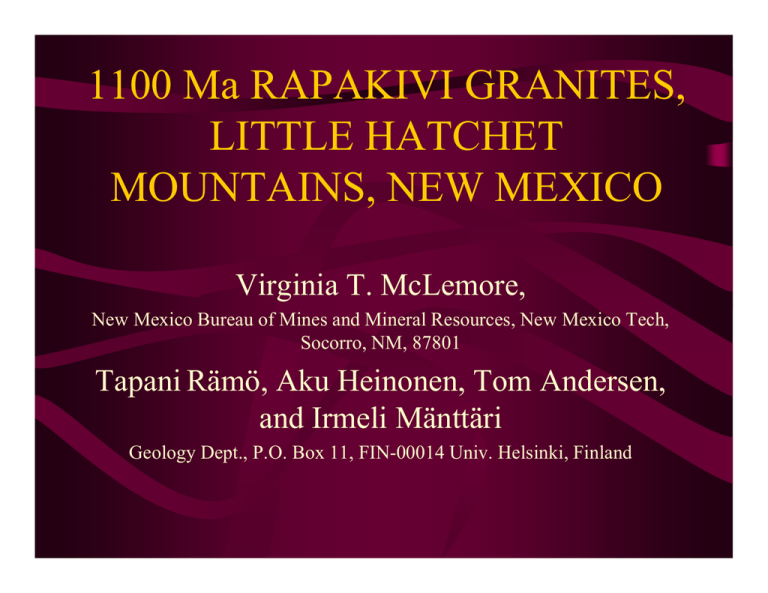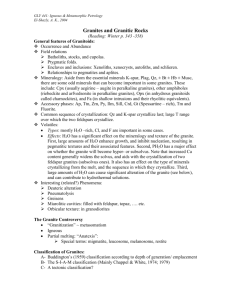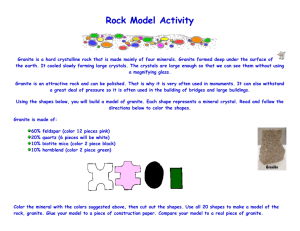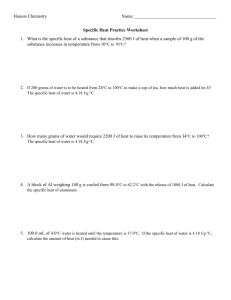1100 Ma RAPAKIVI GRANITES, LITTLE HATCHET MOUNTAINS, NEW MEXICO Virginia T. McLemore,
advertisement

1100 Ma RAPAKIVI GRANITES, LITTLE HATCHET MOUNTAINS, NEW MEXICO Virginia T. McLemore, New Mexico Bureau of Mines and Mineral Resources, New Mexico Tech, Socorro, NM, 87801 Tapani Rämö, Aku Heinonen, Tom Andersen, and Irmeli Mänttäri Geology Dept., P.O. Box 11, FIN-00014 Univ. Helsinki, Finland INTRODUCTION Areas of Proterozoic exposure in southwestern United States and Mexico (modified from Condie, 1981). Names and ages of Grenville (~1200-1000 Ma) areas are shown. IMPORTANCE OF LITTLE HATCHET MOUNTAINS • The association of co-mingled rapakivi granites and diabase is not common in southwestern United States. • There are two distinct granites (rapakivi and hornblende granites) in the Little Hatchet Mountains based on texture, mineralogy, and chemistry. • The Little Hatchet Mountains are one of the southern-most exposures of Proterozoic rocks in southwestern United States. Purpose • To describe the lithology, chemistry, and age of the Proterozoic Little Hatchet granites and spatially associated diabase/gabbro • To provide details on the southern edge of the southern margin of Laurentia METHODS METHODS • Detailed geologic mapping • Geochemistry • U-Pb geochronology (LAM-ICP-MS method on zircon) • Sm-Nd isotopes GEOLOGY hornblende granite/granodiorite orange to red-brown and consists of plagioclase, Kfeldspar, quartz, hornblende, and rare biotite hornblende granite/ granodiorite rapakivi granite pink-gray to red-orange and medium to coarse grained and is characterized by large K-feldspar phenocrysts comingled contact between rapakivi granite and gabbro/diabase comingled contact between rapakivi granite and gabbro/diabase GEOCHEMISTRY Granites (pink rapakivi biotite granite and blue hornblende granite) from the Little Hatchet Mountains A-type granites hornblende granite and rapakivi biotite granite have different compositions AGE concordia diagram for the Little Hatchet rapakivi biotite granite—age is 1066± 4 Ma ISOTOPIC GEOCHEMISTRY Age vs Nd isotope compositions CONCLUSIONS CONCLUSIONS • The rapakivi granite and hornblende granite in the Little Hatchet Mountains are A-type, subalkaline, metaluminous to peraluminous granites. • The hornblende granite and rapakivi granite are chemically different, possibly due to differentiation. • The rapakivi granite and diabase are comingled, indicating a similar age—1066± 4 Ma. CONCLUSIONS - continued • The granites in the Little Hatchet Mountains are chemically similar to the ~1220 Ma Redrock Granite in the Burro Mountains. • The granites in the Little Hatchet Mountains are chemically distinct from the Jack Creek Rapakivi Granite in the Burro Mountains, which is ~1400 Ma. CONCLUSIONS - continued • Co-mingling rapakivi granite and diabase is consistent with a process that involved melting in the upper mantle, emplacement of diabase in the crust resulting in partial crustal melting and thinning, and, finally, intrusion of shallow, high-level silicic plutons, the Little Hatchet rapakivi granite. CONCLUSIONS - continued • The initial Nd isotope compositions of the Little Hatchet granites do not overlap with the evolution of the older country rocks or the regional Paleoproterozoic basement at 1066 Ma. • The granites also have significantly lower depleted mantle model ages (TDM ~1450 Ma) than the Paleoproterozoic rocks exposed at the current erosion level in southern New Mexico (TDM ~1700-1800 Ma) CONCLUSIONS - continued • This suggests that the granites were generated by partial melting of a lower crustal source that was segregated from the mantle during the ~1450 Ma “anorogenic” granite event rather than during the Paleoproterozoic Mazatzal orogeny (17001650 Ma)






